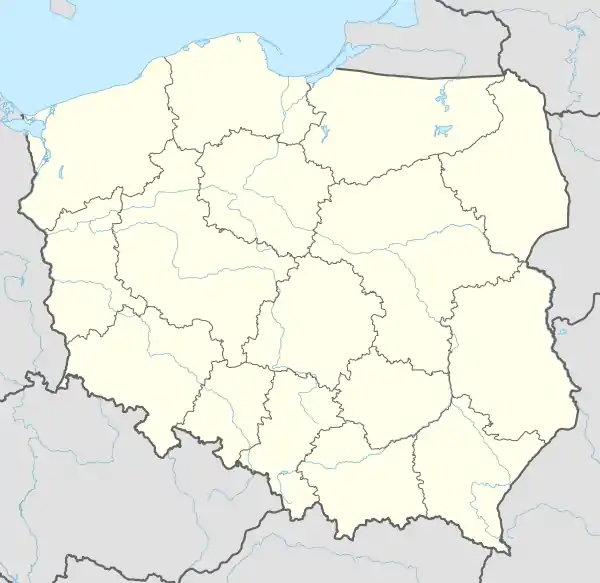Pilica, Silesian Voivodeship
Pilica [pʲiˈlʲit͡sa] is a town in Zawiercie County, Silesian Voivodeship, Poland, with 1,936 inhabitants (2019).
Pilica | |
|---|---|
 Church | |
 Coat of arms | |
 Pilica | |
| Coordinates: 50°27′59″N 19°39′24″E | |
| Country | |
| Voivodeship | Silesian |
| County | Zawiercie |
| Gmina | Pilica |
| Town rights | about 1393 |
| Government | |
| • Mayor | Michał Otrębski |
| Area | |
| • Total | 8.22 km2 (3.17 sq mi) |
| Population (2019-06-30[1]) | |
| • Total | 1,936 |
| • Density | 240/km2 (610/sq mi) |
| Time zone | UTC+1 (CET) |
| • Summer (DST) | UTC+2 (CEST) |
| Postal code | 42-436 |
| Car plates | SZA |
| Website | http://www.pilica.pl |
History
Since the beginning of its existence, Pilica was part of Lesser Poland. In the years 1115–1118 testament of Bolesław III Krzywousty, Pilica became part of the district of Kraków. The probable date of its town rights is 1393. Several years after the uprising of 1 January 1870, Pilica lost its town rights under the Tsar's ukase of June 1, 1869,[2] until it was regained in 1994.
Jewish community
Jews are first mentioned in Pilica in 1581, when they are accused of insulting the host.[3] The historian Meier Balaban notes in his book The History of the Jews of Kraków and Kazimierz 1304–1868 (in Polish): “In the 16th Century the Jewish Kehilla of Krakow was subdivided into seven regional districts: Olkusz, Chrzanow, Wisnicz, Sacz, Bobowa, Pilica, Bedzin, Oshpitzin, and Wolbrom.”[3]
Rabbi Pinchas Eliyahu Rotenberg, the nephew of Rabbi Yitzchak Meir Alter of Gur was rabbi of the town until his death in 1903.[4]
In 1905 Pilica Became a famous center of Hasidism. After a famous tzaddik from Góra Kalwaria died – Rabbi Yehudah Aryeh Leib Alter – a considerable number of Hasidim started to go on pilgrimages to the rabbi’s brother-in-law, Rabbi Pinchas Menachem Justman author of Siftei Tzadik. The latter, on the other hand, was Pilica’s rabbi.[5]
By 1921, the majority of the town's residents were Jewish, with a Jewish population of 1,877 compared to a population of 3,299 overall.[4] The town was occupied by the German army in September 1939. 2,000 Jews were kept imprisoned in a ghetto. In 1942, all the Jews were firstly transferred to the Wolbrom ghetto and then to the concentration camps. Today, no Jews live in Pilica.[3]
References
- "Population. Size and structure and vital statistics in Poland by territorial divison in 2019. As of 30th June". stat.gov.pl. Statistics Poland. 2019-10-15. Retrieved 2020-03-21.
- Szetetl. "Pilica - History". Museum of the History of Polish Jews. Archived from the original on 2 April 2012. Retrieved 1 September 2011.
- "Virtual Shtetl-Pilica-History". www.sztetl.org. Virtual Shtetl. Archived from the original on 3 December 2013. Retrieved 9 August 2013.
- Shmuel Levin and Wila Orbach, translated by Judy Montel (April 2002). "Pilica" (PDF). The Kielce-Radom Special Interest Group Journal. Spring 2002. 6 (2): 3. Retrieved 9 August 2013.
- "Gazeta Kielecka" (78). 1906. Cite journal requires
|journal=(help)
External links
 Media related to Pilica at Wikimedia Commons
Media related to Pilica at Wikimedia Commons- Pilica Official website
- Jewish Community in Pilica on Virtual Shtetl